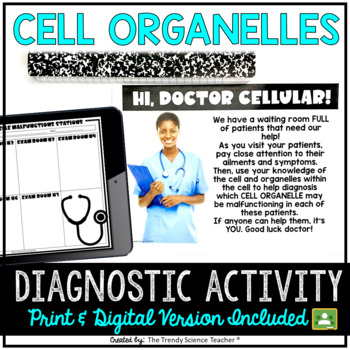Cell Clinic- Cell Organelles Diagnostic Activity
- Zip
- Google Apps™
- Internet Activities

What educators are saying
Description
Assess your students' knowledge of cell organelles with this fun CELL CLINIC- CELL ORGANELLES DIAGNOSTIC ACTIVITY. In this activity, students take on the role of "Dr. Cellular" and travel to 7 exam rooms, making observations about each patient before diagnosing their malfunctioning organelle. This engaging activity is a great way to assess your student and is ready-to-go! No prep involved.
Need a digital option? No problem! I have included both a print and digital version of this activity, making it perfect for distance learning, flipped classrooms, online courses and traditional classrooms.
What's Included:
⭐7 "Exam Room" Stations
⭐Student Answer Document
⭐Answer Key
⭐Editable Version to customize for your classroom needs
⭐Digital (Google Slides) Version
You might also be interested in these resources:
► Introduction to Cells Close Reading Packet
► Cell Organelles Speed Dating Activity
► Properties of Water Lab Station Activity [Print & Digital]
► Is My Teacher a Zombie? Characteristics of Life Activity [Print & Digital]
► BIOMES- Digital Assignment Grid for Distance Learning
► Natural Selection- Digital Assignment Grid for Distance Learning
► Ecology Digital Assignment Grid for Distance Learning
Connect with me:
❤️Newsletter ❤️Blog ❤️Facebook ❤️Instagram ❤️Pinterest
TPT Customer Tips:
How to get TPT credit to use on future purchases: *Please go to your My Purchases page (you may need to login). Beside each purchase you'll see a Provide Feedback button. Simply click it and you will be taken to a page where you can give a quick rating and leave a short comment for the product. Each time you give feedback, TPT gives you feedback credits that you use to lower the cost of your future purchases. Feedback and ratings are most greatly appreciated. Be the first to know about my sales, discounts, freebies and new products: *Look for the green star next to my store logo (THE TRENDY SCIENCE TEACHER) and click it to become a follower. That's it! You will now receive email updates about this store.





